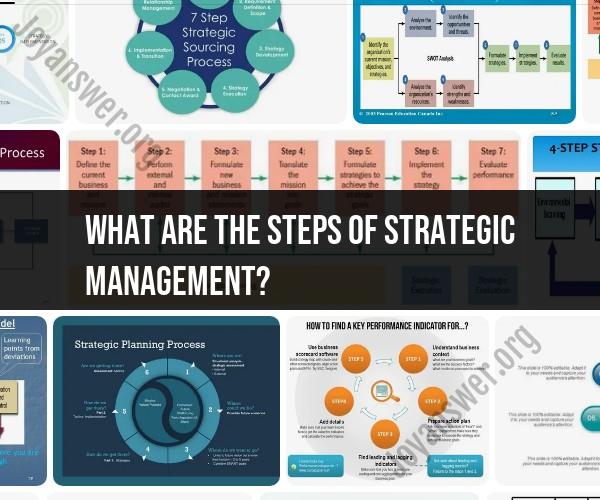What are the steps of Strategic Management?
Strategic management is a process that organizations use to define their long-term goals, make decisions, and allocate resources to achieve those objectives. It involves a series of interconnected steps that guide the organization's direction. While the specific steps may vary by organization, the following is a general outline of the key steps involved in strategic management:
Environmental Analysis:
- Internal Analysis: Assess the organization's strengths and weaknesses, including its resources, capabilities, and performance.
- External Analysis: Examine the external environment, which includes opportunities and threats, market trends, competition, regulatory factors, and economic conditions. This often involves tools like SWOT analysis (Strengths, Weaknesses, Opportunities, Threats).
Mission and Vision:
- Define the organization's mission, which outlines its core purpose and reason for existence.
- Develop a vision statement that describes the desired future state and long-term goals.
Goal Setting:
- Establish clear, measurable strategic objectives that align with the mission and vision.
- Ensure that goals are specific, achievable, relevant, and time-bound (SMART).
Strategy Formulation:
- Develop strategies that outline how the organization will achieve its goals. Consider different approaches, such as cost leadership, differentiation, focus, or diversification, based on the organization's competitive advantage.
Strategy Implementation:
- Allocate resources, including people, funds, and technology, to execute the chosen strategies.
- Assign roles and responsibilities to individuals or teams.
- Develop detailed action plans, budgets, and timelines.
Organizational Alignment:
- Ensure that the organizational structure, culture, and processes are aligned with the selected strategies.
- Communicate the strategy throughout the organization to gain buy-in and commitment.
Monitoring and Control:
- Establish key performance indicators (KPIs) to track progress and success.
- Continuously monitor and assess the performance of the strategies.
- Implement corrective actions when necessary to stay on course.
Strategic Change Management:
- Adapt strategies as needed in response to changing internal or external conditions.
- Handle resistance to change and facilitate smooth transitions.
Risk Management:
- Identify and assess potential risks and uncertainties that may affect the achievement of strategic objectives.
- Develop risk mitigation strategies and contingency plans.
Innovation and Learning:
- Foster a culture of innovation and continuous learning within the organization.
- Encourage employees to generate new ideas and improve existing processes.
Competitive Analysis:
- Monitor competitors and industry trends to identify opportunities for differentiation and staying ahead in the market.
Stakeholder Engagement:
- Engage with various stakeholders, including customers, employees, shareholders, and communities, to understand their needs and concerns.
- Ensure that strategies consider the interests of all stakeholders.
Resource Allocation:
- Make decisions regarding the allocation of financial and non-financial resources based on the priorities set by the strategies.
Ethical and Social Responsibility:
- Ensure that the organization's strategies and actions align with ethical principles and social responsibilities.
- Address environmental and social concerns when formulating strategies.
Performance Evaluation:
- Regularly evaluate the effectiveness of the strategies in achieving the organization's long-term objectives.
- Use performance data to make informed decisions and refine strategies.
Communication and Reporting:
- Keep stakeholders informed about the organization's strategic progress through regular reporting and communication.
Strategic management is an ongoing process that requires adaptability and flexibility in response to changing circumstances. The responsibilities of strategic management are integral to ensuring an organization's sustainability, growth, and success in an ever-evolving business landscape.
The Essential Steps of Strategic Management
Strategic management is the process of setting goals and objectives, analyzing the internal and external environment, developing strategies, and implementing and evaluating those strategies. It is a continuous process that helps organizations to achieve their long-term goals.
The essential steps of strategic management are:
- Goal setting: The first step is to set goals and objectives for the organization. These goals should be specific, measurable, achievable, relevant, and time-bound.
- Environmental analysis: The next step is to analyze the internal and external environment. This will help the organization to identify its strengths, weaknesses, opportunities, and threats.
- Strategy formulation: Based on the environmental analysis, the organization can then develop strategies to achieve its goals. Strategies should be aligned with the organization's mission and vision, and they should be feasible and realistic.
- Strategy implementation: Once the strategies have been developed, they need to be implemented. This involves allocating resources, developing action plans, and assigning tasks to employees.
- Strategy evaluation: The final step is to evaluate the effectiveness of the strategies. This involves tracking progress towards goals, identifying areas for improvement, and making necessary adjustments.
Strategic Management Process: From Planning to Execution
The strategic management process is a continuous process that involves five key steps:
- Strategic planning: Strategic planning is the process of developing a strategic plan, which is a document that outlines the organization's goals, strategies, and objectives.
- Strategic analysis: Strategic analysis is the process of assessing the organization's internal and external environment.
- Strategic decision-making: Strategic decision-making is the process of selecting the best strategies for the organization to achieve its goals.
- Strategy implementation: Strategy implementation is the process of putting the strategic plan into action.
- Strategic control: Strategic control is the process of monitoring and evaluating the implementation of the strategic plan and making necessary adjustments.
Best Practices for Effective Strategic Management
Here are some best practices for effective strategic management:
- Involve all stakeholders: Strategic management should be a collaborative process that involves all stakeholders, including employees, customers, and suppliers.
- Align strategy with mission and vision: The organization's strategy should be aligned with its mission and vision. This will help to ensure that the organization is focused on achieving its long-term goals.
- Be flexible and adaptable: The business environment is constantly changing, so it is important to be flexible and adaptable in strategic planning.
- Monitor and evaluate regularly: The strategic management process should be monitored and evaluated regularly to ensure that it is effective and that the organization is on track to achieve its goals.
By following these best practices, organizations can improve their chances of success in a competitive and ever-changing business environment.













